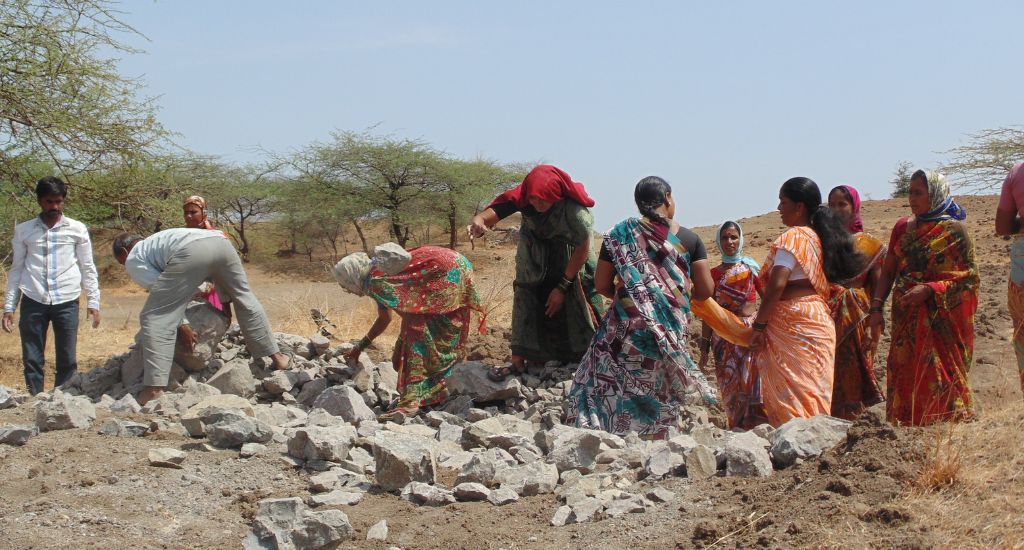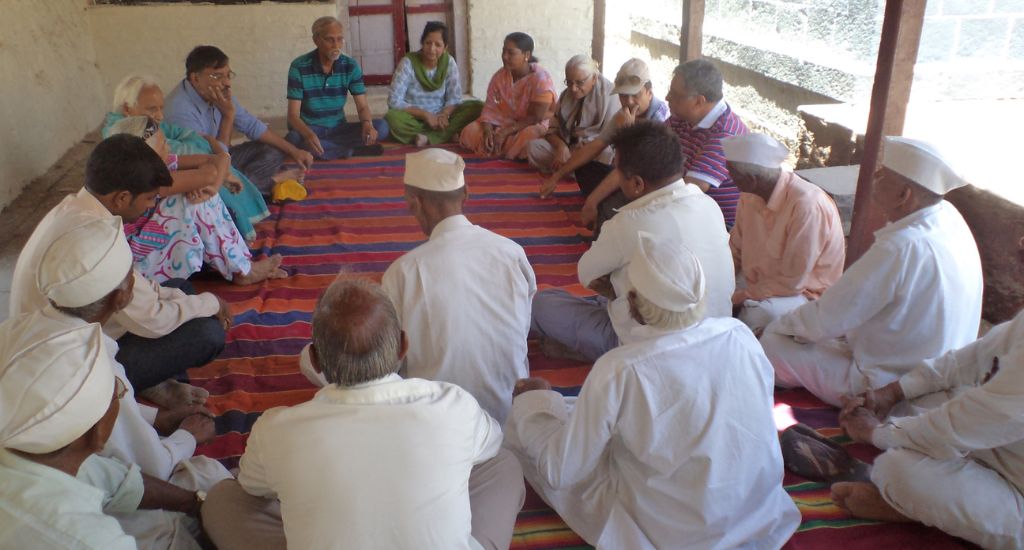
Panchkroshi – Maharashtra farmers harness the power of five
Maharashtra farmers are reviving the traditional concept of Panchkroshi, wherein five neighbouring villages come together, to boost sustainability in their drought-hit region.

Maharashtra farmers are reviving the traditional concept of Panchkroshi, wherein five neighbouring villages come together, to boost sustainability in their drought-hit region.
Extreme weather has had a significant impact on Maharashtra farmers who have witnessed a rise in temperature, erratic rainfall patterns and prolonged dry spells, exacerbating water scarcity. Drought conditions have become more frequent and severe, leading to reduced crop yields, loss of livestock and economic hardships for the farmers in Maharashtra.
Traditional farming practices and water management systems have struggled to cope with the changing climate, highlighting the urgent need for adaptation strategies, such as water conservation, crop diversification and the implementation of sustainable farming techniques.
The concept of “scaling up” has become crucial for farmers seeking additional activities alongside their primary occupation. Assisting in this endeavour is the Gram Gaurav Pratisthan, a programme offered by an NGO, Pani Panchayat. Efforts are being made to support farmers through government initiatives, technological advancements and community-driven approaches to build resilience and mitigate the adverse effects of climate change on agriculture in the state.
The Panchkroshi system, although known by different names, has long been practised throughout the country. It involves the pooling of resources from five neighbouring villages, offering the scale required for successful and enduring endeavours.

As a decentralised cooperative system, it paves the way for sustainable development while nurturing the needs of its beneficiaries. Recognising the advantages of this almost forgotten system, Pani Panchayat began an initiative to revitalise it, leveraging its cost-effectiveness, low maintenance requirements and ability to strengthen village ties.
Khalad, the first village to join the project, united five villages to share resources, primarily water sourced from the nearby Karha, a tributary of the Nira river. The project’s initial phase involved revitalising old irrigation channels, known as “paat”, which had fallen into disrepair over time.
These gravity-based channels require no electricity, pumps or pipelines, rendering them sustainable and cost-effective. As a result, farmers now have access to water until December, covering the entire Kharif season and a significant portion of the Rabi season.
Also Read | The lack of sustainable farming prospects in India
Kashinath Raskar, a resident of Chavanvasti village, stands among the beneficiaries of this project. It allowed him to establish a thriving dairy business. Sheetal Raskar, his wife, while tending to her chores of managing their herd of cows, recounted the venture’s beginnings.
“We started with a couple of cows, but one passed away. Around that time, water reached us through the Panchkroshi effort, enabling us to scale up. Today, we own 28 cows, and 21 of them yield approximately 250 litres of milk daily,” Sheetal said, emphasising, “Five years ago, we had no water.”

Kashinath added his aspirations: “I want to expand and establish my dairy with at least 100 cows, and I hope our son becomes a veterinary doctor. There is a significant need for veterinary services in our area.”
The Raskar family earns Rs 3 lakh a month, with a net profit of around Rs. 1.5 lakh after deducting costs. This exemplifies the transformative power of water reaching households. Under this project, the overarching goal is to satisfy the village’s needs primarily through local or nearby sourcing, within the Panchkrosh cluster.
The Pani Panchayat initiated a trial project in 2016-17 with five villages near Saswad, the headquarters of Purandar taluka, located approximately 40km from Pune. These villages were selected due to their similar agro-climatic conditions and shared socio-cultural ethos. The primary focus was on addressing the villagers’ most basic requirement – water.
Ensuring effective management of this vital resource would not only improve life but potentially even reverse the trend of migration to cities in search of employment.
Also Read | This Maharashtra village is home to 10 aromatic rice varieties
Nearly five years after the pilot project’s commencement, it now spans almost 700 acres, encompassing 10 villages in Purandar taluka. Work is on to expand this coverage by an additional 200 acres, benefiting 150-200 more families.

According to Dr Sonali Shinde, the managing trustee of Pani Panchayat, they have also started working in Koregaon village, located in the drought-prone Satara district.
The fundamental objective of the project is strengthening and empowering villagers to enable them to make independent decisions regarding their aspirations and the means to achieve them.
“Ideally, we aim for a village’s needs to be met either internally or sourced from within a 100 km radius,” Shinde said. Local sourcing ensures that money remains within the community, and the formation of the Panchkrosh cluster ensures the achievement of scale.
Nitin Ingle, a farmer from Walunj village, also swears by the effectiveness of the system. He holds about five acres of land used mainly for horticulture. Ingle started a fruit processing centre on his land in 2017, initially on a trial basis.
“We see the demand for a fruit rising when it’s not in season, and falling as soon as it hits the market. This mismatch got me thinking about setting up a processing unit to ensure supply through the year,” Ingle said.
Today, Nitin Foods processes about 4 tonnes of custard apple, 6 tonnes mangoes, 2 tonnes jamun and about a ton or two each of guava and chikoo to make fruit pulp. Ingle is in the process of setting up a jam factory too. The focus of all his endeavours is the farmer. He is assisted in the project by Pani Panchayat, which offers him advice and links him with other farmers and technical advisors in the region.
Also Read | Papads and pickles empower women in Maharashtra

“I am a farmer myself and I always keep the farmers’ interests in mind,” he said.
Also an active participant in the scaling up process is Yogesh Magar, 24, who holds a masters degree in environmental sciences from Savitribai Phule Pune University. Magar collects and propagates seeds of indigenous trees like tamarind and amla. These are then distributed to villagers or used for setting up sacred groves. The harvest from the trees is sold in the market, contributing to the farmers’ household income in Maharashtra, through an activity locally called zod dhanda (allied business).
The initiative matches the focus on sustainability and propagation of indigenous flora, and Magar also trains Maharashtra farmers in this aspect while he works for Pani Panchayat.
Prashant Borawake, the programme manager at the organisation, highlighted the cooperative nature of their work.
Speaking about a processing centre established by them, he said, “We want women, in particular, to come and utilise the machinery for processing their agricultural produce. Ultimately, we want them to buy the machines. This will increase their incomes and generate local employment, as the machines will require maintenance. That is what we envision as a virtuous cycle.”
Also Read | Strawberry sweetens deal for Maharashtra farmers
The lead image at the top shows a group of villagers at work to dig a well (Photo by Gouri Agtey Athale)
Gouri Agtey Athale is a Pune-based freelance journalist.